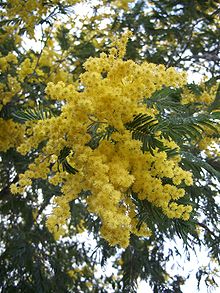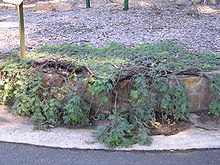- Acacia dealbata
-
Acacia dealbata 
Foliage and flowers Scientific classification Kingdom: Plantae (unranked): Angiosperms (unranked): Eudicots (unranked): Rosids Order: Fabales Family: Fabaceae Genus: Acacia Species: A. dealbata Binomial name Acacia dealbata
LinkAcacia dealbata (known as Silver Wattle or Mimosa[1]) is a species of Acacia, native to southeastern Australia in New South Wales, Victoria, Tasmania, and the Australian Capital Territory.[2]
Contents
Description
It is a fast growing evergreen tree or shrub growing up to 30 m tall, typically a pioneer species after fire. The leaves are bipinnate, glaucous blue-green to silvery grey, 1–12 cm (occasionally to 17 cm) long and 1–11 cm broad, with 6–30 pairs of pinnae, each pinna divided into 10–68 pairs of leaflets; the leaflets are 0.7–6 mm long and 0.4–1 mm broad. The flowers are produced in large racemose inflorescences made up of numerous smaller globose bright yellow flowerheads of 13–42 individual flowers. The fruit is a flattened pod 2–11.5 cm long and 6–14 mm broad, containing several seeds.[1][3] Trees generally do not live longer than 30 to 40 years, after which in the wild they are succeeded by other species where bushfires are excluded. In moist mountain areas, a white lichen can almost cover the bark, which may contribute to the descriptor "silver".[citation needed]
Subspecies
There are two subspecies:[2]
- Acacia dealbata dealbata. Low to moderate altitudes. Tree to 30 m; leaves mostly 5–12 cm long.
- Acacia dealbata subalpina Tindale & Kodela. High altitudes in the Snowy Mountains. Shrub to 5 m (rarely 10 m) tall; leaves mostly 1.5–8.5 cm long.
Some authorities consider A. dealbata to be a variant of Acacia decurrens.[1]
Cultivation and uses
Acacia dealbata is widely cultivated as an ornamental plant in warm temperate regions of the world,[1] and is naturalised in some areas, including southwestern Western Australia, southeastern South Australia, Norfolk Island, the Mediterranean region, California,south-western China and Chile.[3][4][5][6] It does not survive prolonged frost.[1]
The timber is useful for furniture and indoor work, but has limited uses, mainly in craft furniture and turning. It has a honey colour, often with distinctive figures like birdseye and tiger stripes. It has a medium weight (540–720 kg/m³), and is similar to blackwood.[citation needed]
The flowers and tip shoots are harvested for use as cut flowers, when it is known by florist trade as "mimosa". In Italy, Russia and Georgia the flowers are also frequently given to women on International Women's Day.[citation needed] The essence of the flowers, called cassie or apopanax, is used in perfumes. The leaves are sometimes used in Indian chutney.[1]
In New Zealand the Department of Conservation class it as an environmental weed.[7] It has been analyzed as containing less than 0.02% alkaloids.[8]
References
- ^ a b c d e f Gualtiero Simonetti (1990). Stanley Schuler. ed. Simon & Schuster's Guide to Herbs and Spices. Simon & Schuster, Inc. ISBN 0-671-73489-X.
- ^ a b Australian Plant Name Index: Acacia dealbata
- ^ a b Flora of Australia Online: Acacia dealbata
- ^ Flora Europaea: Acacia dealbata
- ^ Jepson Flora: Acacia dealbata
- ^ Michail Belov: [1], Chileflora. Consulted 2010, September 22.
- ^ Howell, Clayson (May 2008). Consolidated list of environmental weeds in New Zealand. DRDS292. Wellington: Department of Conservation. ISBN 978-0-478-14413-0. http://www.doc.govt.nz/upload/documents/science-and-technical/drds292.pdf. Retrieved 2009-05-06.
- ^ Chemotaxonomie der Pflanzen By Robert Hegnauer
Categories:- Acacia
- Trees of Australia
- Fabales of Australia
- Flora of New South Wales
- Flora of Tasmania
- Flora of Victoria (Australia)
- Invasive plant species in South Africa
Wikimedia Foundation. 2010.

